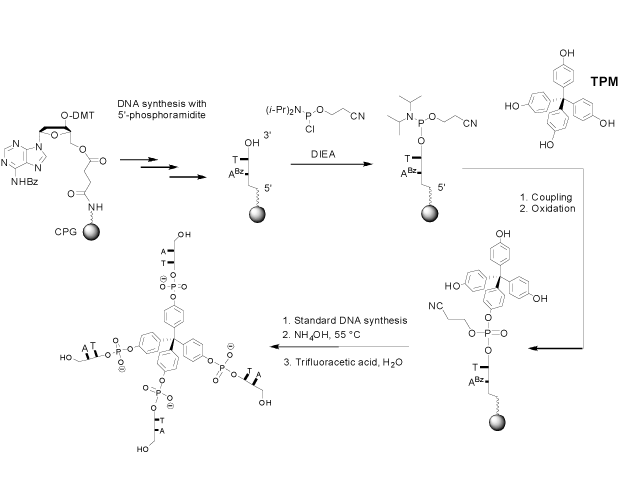Glen Report 22.28: Technical Brief - Symmetrically Branched Four-Arm DNA
Nature evolved DNA as a linear polymer. As a genetic material, this linear polymer is a wonderful compound to work with. However, for molecular construction and supramolecular chemistry, the linear structure of DNA is a severe limitation. Positioning structural elements at defined positions and creating densely cross-linked 3D materials requires branching points not found in natural oligonucleotides. Glen Research offers branching elements for custom DNA syntheses, such as 5-Me-dC Brancher Phosphoramidite and Trebler Phosphoramidite. These contain flexible alkyl chains that provide conformational flexibility to the resulting branched chains. Recently, Meng et al. reported that a more rigid, symmetrical branching element gives access to four-arm DNA hybrids with surprising properties.1 When the four chains of a symmetrically branched oligonucleotide are linked by tetrakis(p-hydroxyphenyl)methane (TPM), the DNA hybrids obtained have an extreme propensity to assemble into three-dimensional networks.
For these rigid hybrids to form, two strong base pairs per DNA arm will suffice to induce the formation of a solid upon addition of magnesium cations to micromolar solutions in conventional aqueous buffer.1 The new nanoporous material has interesting properties and can readily be stained with intercalators. The synthesis of the rigid hybrids (Scheme 1) is more complicated than that of branched oligonucleotides with flexible chains, but it is still simpler than the solution phase syntheses of other symmetrical hybrids.2 The combination of reversed or 5’-phosphoramidites (stage 1), on-support phosphitylation, and conventional 3’-phosphoramidites ensures that all chains are attached via the 3’-terminus, but some off-synthesizer steps are required. Glen Research will be happy to make TPM available to interested researchers upon request.

Synthesis of symmetrically branched oligonucleotides
with rigid core via two-stage solid-phase synthesis.
References
- M. Meng, et al., Chembiochem, 2009, 10, 1335-9.
- O. Plietzsch, et al., Org Biomol Chem, 2009, 7, 4734-43.
Product Information
- Glen Report 22.21: 2’-F-Arabinonucleic Acid (2’-F-ANA)
- Glen Report 22.22: New Products – dX and Ferrocene-dT
- Glen Report 22.23:; New Product: 0.5M CSO for non-aqueous oxidation in DNA synthesis
- Glen Report 22.24: New Product - Universal Tosyl Phosphoramidite
- Glen Report 22.25: New Products - Glen Gel-Pak™ DNA/RNA Desalting and 1000Å Glen UnySupport™ Frits
- Glen Report 22.26: New Products – Azide Tags for Click Chemistry
- Glen Report 22.27: Deprotection – Volume 5 – On-Column Deprotection of Oligonucleotides in Organic Solvents
- Glen Report 22.28: Technical Brief - Symmetrically Branched Four-Arm DNA
- Glen Report 22.29: Technical Brief - Crosslinking with Click Chemistry
- Glen Report 22.210: Glen-Pak™ Product Update: New Protocols for Purification

